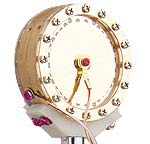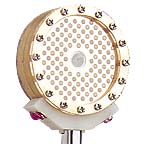|
They all do one thing
Microphones appear in an almost endless variety of shapes, sizes and
design types. Their purpose is same: to convert acoustic vibrations
to electrical energy so it can be amplified or recorded. Most achieve
this by the action of the air vibrating a diaphragm connected to something
that either creates or allows a small electron flow. Recording, sound
reinforcement, broadcast, telecommunications, all have specialist microphones
that have evolved over the years to suit particular intended purposes.
One purpose is studio recording and a common product is the condenser
microphone.
The Studio Condenser
There are many types of studio condensers but they can be narrowed down
to two basic types: cardioid and omni-directional. Some of the more
complex studio condensers have variable pattern control and have multiple
patterns that can be selected to manipulate its pick up characteristics
|
  |
 |
How it works?
Imagine the classic “studio Mic”. You may have seen pictures
of the gold disc capsule often with a wire screwed into the centre on
one side and the gold plate with little holes on the other. Inside the
mic will be some electronics and a power supply. Some microphones have
the power supply in a separate box. The gold discs represent two electrically
charged plates, one that can move and one that is fixed. This is in
effect, a capacitor with a positively and negatively charged electrode,
and an air space between.
|
  |
|
A pressure gradient device?
The cardioid condenser microphone is a pressure gradient device,
responding to the differences in sound pressure on each side of the
diaphragm. In operation, sound passes the diaphragm depressing it and
causing a change in the spacing between it and a charged metal back
plate. The electrostatic attraction between the plates increases. This
change in capacitance and distance between it and the back plate causes
a change in voltage potential that can be amplified to a recordable
level. To boost this small variation in voltage, originally a vacuum
tube and later FET transistors were employed. This is why a battery
or phantom power is needed to charge the plates and also to run the
pre amp.
|
 |
|

|
The directional effect
The directional effect of the cardioid microphone is achieved by adding
little holes in the back plate. The holes create a sound entrance and
delay network. The object is to delay the arrival of sound at the rear
of the diaphragm to coincide with the same sound at the front. This
way the sound is cancelled out. The size and position of the holes determines
the frequencies that will be cancelled. The Mann microphone capsule
has a second diaphragm at the back, but more about that later.
|
 |
|
The multi pattern microphone
Another type of condenser microphone is the Multi pattern condenser
type. This design is generally composed of a single plate between two
diaphragms. A variable resistor set between the two diaphragms and the
plate determine how much signal from each diaphragm is fed to the pre
amp. In this system the rear diaphragm in conjunction with the holes
that run through the plate become part of the phase shift when the unit
is selected to a cardioid pattern. As a result, this microphone can
have selectable patterns ranging from a tight cardioid through to a
figure eight and finally to full omni directional.
|
|
|


